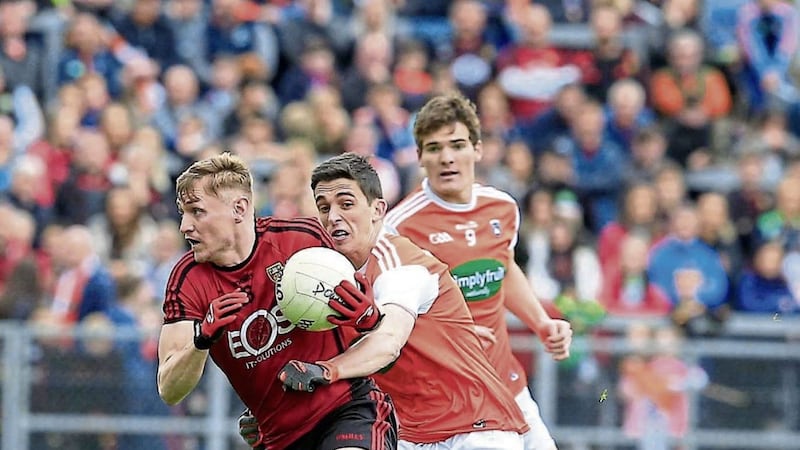PERHAPS the most difficult skill to explain in football terms is the tackle. It has been an enduring topic of debate.
The 2019 Official Guide, Section 2 explains it as a ‘skill by which one or more players may dispossess an opponent or frustrate his objective within the Rules of Fair Play.’
It goes on to say a tackle is aimed at the ball, not the player, that the body can be used in the confrontation and that at least one foot must be on the ground when executing a tackle. The usual exemptions apply: no punching, slapping, arm holding, tripping, jersey pulling or full-frontal charges are permitted. Sure that is all grand until you try to coach the art of the tackle.
The first problem is the inconsistencies within the rulebook. Let me give you an example. Armagh’s Paul McGrane (inset) had an uncanny knack of tackling a player and somehow being able to swing his arm around the back of the man as he’d almost evaded his tackle to successfully punch the ball out of his grasp.
It was unorthodox but it was effective.
In the eyes of many referees this tackle was permitted, but for others it constituted an infringement of the rules.
So what aspect of the rules were violated?
Well, according to the Rules of Fair Play, there were no infringements. McGrane tackled the ball, he would have at least one foot firmly in contact with the ground and the player would be unharmed.
In order to understand the above error and to coach the tackle, not only must you read the section on Rules of Fair Play, but you must also read the entire Official Guide.
Neatly tucked away on page 83 under the section Aggressive Fouls, it states it is a foul to ‘use the fist on or around the body of an opponent for the purpose of dispossessing him of the ball,’ the penalty being a free-kick.
Suddenly we now learn that a player cannot tackle an opponent with a closed fist regardless of whether he aims at the ball or dislodges it cleanly.
We’ve seen in each Championship match to date a range tackles which are deemed to be soft or harsh, depending on your perspective.
In most instances there is an interpretation to be made by the referee who, despite his best endeavours, is influenced by his or her own biases and other environmental factors.
Referees who enjoy physical contact tend to officiate with the whistle in their pocket.
Those who eat, sleep and breathe the rulebook have also swallowed the whistle and blow it each time they exhale. Of course, in every situation, the rulebook says the referee is right – he always is and any remonstration to convince him he got it wrong is often met with further punishment.
A number of incidents occurred in recent weeks where two players collided, resulting in differing penalties.
In two incidents in particular, both referees were experienced officials and both control the game in similar style, in my view. So I ask myself, which one was right?
Take the Caolan Mooney incident during the Down v Armagh Ulster quarter-final.
Mooney did not raise his arms to shoulder level or above, nor was there was intent to cause harm.
In real time the referee interpreted his tackle as a deliberate attempt to make contact with the player and not the ball (a certain free), and to behave in a way which is dangerous to an opponent.
Anthony Nolan’s interpretation left him with no option but to issue a red card. Was his decision biased by the location of the tackle on the field or by other previous incidents of a similar nature which went unpunished and which had a cumulative impact upon his decision?
Similarly, in the Donegal v Fermanagh game, Paddy McGrath (right) caught a Fermanagh player neck high but, realising his error, he applied zero force even though the player went to ground.
On this occasion Joe McQuillan took a measured approach to the perceived level of danger.
In awarding a free he also issued a yellow card to McGrath.
This tackle occurred 45 yards from goal along the sideline with about 13 Donegal men yet to beat before any hope of a score.
It was an uncompromising, but good-spirited game. Atmosphere and in-the-moment tensions undoubtedly influence decisions.
Most supporters want the game to be manly and for players to bravely brace themselves for all tackles and to discard the feigning practices which have crept into football.
Should a player be punished to the extent that they receive a red card, they should richly deserve it – there should be no doubt.
Had yellow cards been issued in both instances, supporters would have been accepting of the decision.
Does that mean the referee got the Mooney decision wrong? In answering that question, we must be reminded that one player was clearly injured in that tackle.
The top referees get the decisions right 99 per cent of the time. The remaining one per cent are the key decisions which frequently involve brandishing a black or red card.
These decisions require a calm head – maybe two calm heads.







